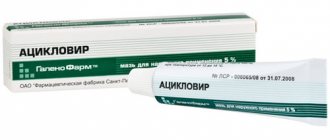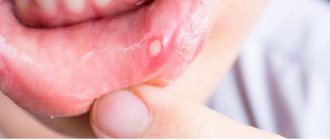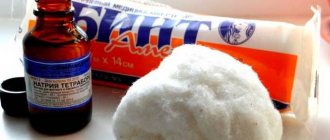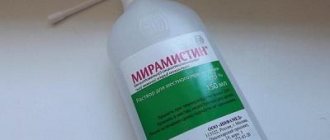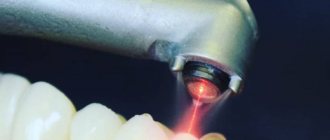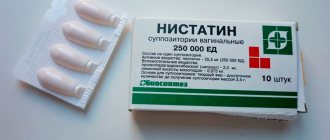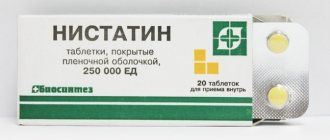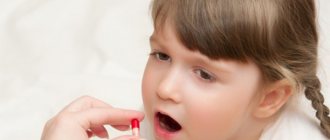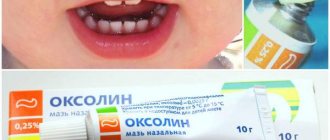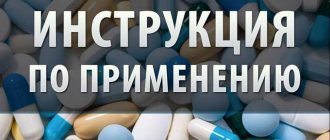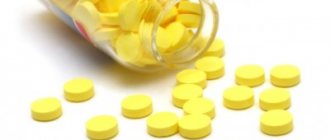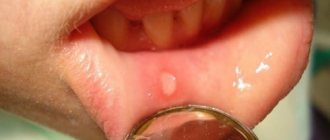Before using nystatin for stomatitis, you need to accurately identify the symptoms. A disease that affects the mucous membrane (ulcers, redness, swelling) of the oral cavity is called stomatitis. In this case, pathogens can be of viral origin, fungal infection or bacteria.
As a rule, infants under 12 months are diagnosed with a disease caused by fungi, as well as candidal stomatitis (also called thrush). This species gets its name from Candida fungi, and the disease can also affect older children.
The presence of childhood stomatitis in a child can be judged if the following symptoms are present:
- - painful or unpleasant sensations in the mouth or mucous membranes;
- - ulcers in the form of a white coating (dense formations of stomatitis on the cheek, palate, tongue, lips);
- — the presence of high temperature (sometimes to high values).
In the fight against the pathogen of the genus Candida, along with other tablets and ointments for stomatitis in the mouth, Nystatin is very effective.
Nystatin for stomatitis - instructions
The medicine has its pros and cons in its use. Being an antibiotic, the drug fights fungal infection and is capable of destroying the pathogen in entire colonies. At the same time, it penetrates into the harmful cell and destroys it from the inside.
By using Nystatin in small doses, you can stop the action of thrush. Regular use of the medicine leads to complete victory over the fungus.
"Nystatin" has undeniable advantages compared to a number of similar drugs for the same purpose, such as:
- — ease of use;
- - low price;
- - local effect on the pathogen - in this case the medicine does not penetrate into the blood;
The product involves targeted use - it should be applied only to the very surface of the affected areas.
The medicine, like many, has its own symptoms of overdose.
These are:
- — itching in those places that are treated with the drug;
- - redness of the mucous membrane;
- - swelling;
- - burning sensation;
- - individual intolerance to the drug.
The active substance of this medication is quite powerful, as a result of which experts recommend using it a maximum of twice a day (all other things being equal) . Usually the duration of the course does not exceed two weeks.
Treatment of stomatitis with nystatin in a small child
The instructions for use of the drug directly indicate the permissibility of using the medication for infants. In pharmacies, Nystatin is presented in the form of drops, ointments and tablets.
For babies who have thrush, the best option is to use a tablet solution. It can be obtained independently - the tablet will need to be carefully crushed into small crumbs and diluted in a solution containing vitamin B12, and the latter is best used in oil form.
After this, the finished mixture is brought to a homogeneous state. In this way, you can dilute nystatin and treat a child for stomatitis.
Treatment of affected areas should be done no more than 3 times a day.
In the absence of a vitamin solution, boiled water is also quite suitable; the effect of such a replacement is similar.
In some cases, the doctor prescribes tablets for infants. How, then, should they be used correctly?
- — The dosage should be a quarter of one tablet.
- — It is unacceptable to feed a baby or give him water within a 30-minute period after taking the medicine.
In a situation where it is intended to use Nystatin drops, the dosage is calculated based on 1 ml of solution for each baby’s cheek. To do this, use a sterile bandage - drops are applied to it, then the areas affected by stomatitis are delicately treated.
The duration of treatment is determined by the degree of damage; the course must be prescribed by a doctor. As a rule, the medicine is used for no more than 10 days.
The popular doctor E. Komarovsky advises not to forget that Nystatin is still an antibiotic, therefore, to treat candidiasis-type stomatitis, you must strictly follow the prescribed dosage.
Prevention
In order to avoid the development of thrush in infants, mothers must adhere to certain rules:
- when breastfeeding, before putting the baby to the breast, it must be washed with boiled water;
- after feeding or regurgitation, it is necessary to give the child something to drink to wash away food particles and neutralize the acidic environment;
- Before working with a baby, you must wash your hands;
- You should not give your child unwashed toys or a pacifier. They must be boiled or treated with soapy water at least once a day;
- It is recommended to regularly treat all baby items intended for feeding or playing with aseptic solutions or soda;
- It is advisable to clean the child’s mouth once a day using moistened gauze placed on a finger;
- You should not uncontrollably give your child medications or foods that are inappropriate for the child’s age.
- do not kiss the child on the face;
- thoroughly wash toys and objects that are near the child;
- wash nipples and bottles with baking soda and boiling water;
- for a nursing mother, observe the rules of personal hygiene, treat nipples with 2% soda solution or borax;
- wash your hands thoroughly before picking up your baby;
- Mothers should avoid taking antibiotics while breastfeeding.
We invite you to read: Furacilin for stomatitis in adults and children: instructions for use
Instructions for the use of nystatin in older children
Older children are advised to dissolve tablets of the drug. The doctor can also prescribe medication to be taken orally; the daily dose is also selected by the doctor ; it is determined by the degree of damage and the body’s response to the disease.
You should not select the daily dosage by eye. You need to find out which doctor treats stomatitis, go to him and get a consultation.
Usually in these cases you need to take the remedy 3-4 times daily, and this should be done after meals .
You do not need to chew the tablet, but you should take it with plenty of liquid.
The duration of the course is prescribed by the doctor who conducts the treatment.
Usually the doctor prescribes the following dosage:
- - child 1-3 years old: 250,000 units, taken 3-4 times a day;
- - child 3-14 years old: 250,000 or 400,000 units, taken with the same frequency;
- - child over 14 years old: 250,000 / 500,000 units. also 3-4 times a day.
Nystatin in the form of an ointment can be prescribed by a doctor for older children. Application of this (5%) should be carried out a maximum of three times a day. Nystatin for stomatitis completely destroys fungal colonies, as a result of which the patient quickly recovers. The duration of the course is also determined by the depth of the fungal infection.
The drug also has contraindications - in the vast majority of cases it is an allergy to the drug.
So is it worth treating stomatitis with this remedy?
The drug is very effective, reviews of its use are mostly positive. There are also side effects as a result of use, but few have been noted - they are usually limited to diarrhea or nausea. The use of the medicine in the form of an oil (water) solution or ointment practically reduces the side effects to nothing.
Doctor's comments:
- - if “Nystatin” in the form of an ointment or solution was accidentally swallowed by a child, the drug leaves the body in the usual way without causing harm to the baby;
- - it is undesirable to use the medicine without prior consultation with a specialist;
- — the drug in many situations is more effective than similar modern drugs.
However, this drug is an antibiotic, so before using nystatin for stomatitis, you will definitely need to consult a pediatrician.
"Nystatin" belongs to the group of antifungal antibiotics from the polyent category. Nystatin is often prescribed for stomatitis for local treatment of affected areas. The drug works at the cellular level, reducing the cell membranes of fungi and slowing down their growth. The most active against yeast-like fungi is Candida. According to the instructions for use, the medication is approved for use from infancy. Available in several forms: tablets, drops, ointment, suppositories, suspensions for rinsing. Frequency of application: 2 times/day. during the course of treatment - 14 days. A more precise adjustment is made by the doctor based on the severity of the disease and the age category of the patient.
Contraindications and overdose
Like any other medicine, Nystatin has certain limitations. In particular, the instructions for use recommend stopping taking the drug in cases where:
- increased sensitivity to components,
- predisposition to allergic reactions,
- disorders of the pancreas, liver or kidneys,
- stomach ulcer,
- pancreatitis.
The dosage should also be observed with extreme care. Uncontrolled use of the drug for the treatment of stomatitis can lead to unpleasant consequences, such as:
- itching and burning in the treated area,
- swelling of the mucous membrane and hyperemia,
- the appearance of a small rash on the skin.
Description
"Nystatin" is included in the group of specific and active antibiotics with antifungal properties. The medication destroys colonies of yeast-like fungi Candida at the cellular level, which contributes to the rapid fight against candidal stomatitis in children and adults. Small doses of the product are sufficient to effectively slow down the development of thrush. With systematic treatment, the fungus is completely destroyed.
When applying small doses of the product, the development of thrush slows down. With systematic use of the medicine, complete destruction of the fungus is observed. Benefits of use for stomatitis:
- low price;
- ease of use;
- lack of absorption into the systemic bloodstream;
- Possibility of treating wounds in infants.
The drug is applied pointwise only to the surface of wounds and erosions.
Features of the treatment of stomatitis with Nystatin:
- The drug in the form of an ointment against stomatitis is applied pointwise only to the surface of wounds and erosions.
- For the treatment of infants, an aqueous solution of tablets is used orally or a solution with vitamin B12 for local treatment.
- Drops are used for local sanitation of the oral cavity.
In case of an overdose of an anti-stomatitis drug, the following symptoms are observed:
- burning and itching in the treated area;
- hyperemia and swelling of the mucous membrane;
- development of a skin allergic reaction.
The maximum course of treatment against candidiasis in the mouth is 14 days when treated 2-3 times a day. The peculiarities of using Nystatin in different age categories are taken into account by the doctor when prescribing the drug.
Return to contents
Symptoms
- A curdled white coating in the mouth (can cover the tongue, gums, inner surface of the cheeks, palate, tonsils, tonsils)
- The mucous membrane under the plaque is inflamed or bleeding
- Itching and soreness of the mouth
Secondary symptoms:
- Poor appetite (refusal to breastfeed or bottle)
- Crying while feeding
- Sleep disturbance at night
- General malaise
- Moodiness and irritability
- Temperature rises to 37-38 degrees
The symptoms of thrush cannot always be identified the first time. Parents often confuse it with the usual plaque that occurs after feeding a child artificial milk formula. The presence of thrush can be determined by specific signs:
- the plaque has a cheesy character and is difficult to remove from the mucous membranes;
- when it is removed, hyperemic areas of the mucous membrane are exposed, which can bleed;
- the appearance of plaque is accompanied by irritability and tearfulness of the child, since the affected areas are characterized by severe pain;
- the baby refuses to eat;
- As inflammation grows, plaque gradually covers the entire surface of the oral cavity, forming a thin film. It then spreads to the lips and larynx;
- the disease is accompanied by stool disturbances and fever.
In the mouth
Thrush in children in the first months of life and in newborns is most often localized in the mouth. The primary signs of thrush in a child are a white, cheesy coating on the tongue, gums, and buccal mucosa (see photo). Plaque can be in the form of thin white stripes, plaques, or plugs on the tonsils in the throat.
The mucous membrane under this coating is red and inflamed (see photo). Candidiasis in newborns and older children can be localized on the lips, in the corners of the mouth (cheilitis). Secondary signs are restless sleep, refusal to eat, and crying. Throat candidiasis most often affects children one year of age and older. Usually children weakened by illness or vitamin deficiency.
Body temperature can be within normal limits, or it can be raised to 38 degrees. The child feels weak, unwell, and has a sore throat. But sometimes thrush appears asymptomatically, or with very mild symptoms.
Vaginal
The fungus can affect the walls of the vagina in girls (vaginal thrush); in boys, the skin of the head of the penis can be affected (candidal balanitis). The main signs of vaginal thrush are itching, cheesy discharge, and inflammation of the genitals.
Children who can already speak usually complain to their mothers that their pussy itches; in newborns, thrush causes anxiety and crying.
Thrush is a disease caused by fungi of the genus Candida.
In women, thrush manifests itself in the form of yeast-like vaginal discharge, an unpleasant odor and itching in the outer part of the vagina. Also, quite often, thrush in women can affect the mucous membrane of the nose, pharynx and oral cavity.
We suggest you read: A child grinds his teeth in his sleep: what is the problem?
Release form
There are four main forms of the drug used for stomatitis:
- drops;
- solution;
- pills;
- ointment.
These forms differ in the concentration of the active ingredient, cost, and treatment principles:
- tablets packed in 10 or 20 pcs. in the package they are used orally for complex therapy of the disease;
- ointment packaged in tubes of 15-20 g and active substance concentration - 100 thousand units;
- drops of 5 ml - for local sanitation of the oral cavity;
- suspension for rinsing (dosage 200 thousand units).
Rectal suppositories are prescribed less frequently (10 pieces, 300-500 thousand units of active ingredient each). Powders for oral solution are also available. The powder can be used in its original form for local treatment.
Vitamin B12 can be used to dilute any form of the drug.
Return to contents
How to use?
Due to rare cases of side effects, which are more often manifested by nausea and stool upset, the drug in any form can be prescribed to older patients and children from infancy. The drug is used topically in the form of ointments, aqueous solutions or suspensions with vitamin B12, as well as orally.
Return to contents
In older patients
The older age group of patients is prescribed a dosage of the drug of 500 thousand units. active substance. The tablet form is most often used for complex therapy of severe or advanced forms of candidal stomatitis, as well as ointments for local treatment of wounds and ulcers. Treatment lasts 10-15 days, the frequency of doses per day is prescribed individually.
Return to contents
In young patients
Children under 14 years of age are prescribed tablets to be absorbed behind the cheek.
For children under 14 years of age, to cure stomatitis, tablets are prescribed to be absorbed behind the cheek. If necessary, oral tablets can be prescribed according to the following principle:
- multiplicity - 3-4 rubles/day;
- taken after meals with a significant amount of water;
- course - 10-14 days;
- dosage: 1-3 years - 250 thousand units;
- 3-13 years - 250/400 thousand units;
- from 13 years - 250/500 thousand units.
For local treatment of the oral mucosa, a 5% ointment is prescribed. It should be applied to foci of fungal infection after meals, up to 3 times a day, using cotton swabs. Upon penetration into the gastrointestinal tract, the ointment is not absorbed and is therefore excreted in its original form.
Return to contents
In infants
To cure stomatitis in infants, ready-made aqueous solutions or drops, solutions of tablets in vitamin B12 are prescribed for local treatment. To do this, 1 tablet (250 thousand units) must be crushed into powder and diluted in a vitamin ampoule or a glass of boiled water.
After stirring the finished product until smooth, you need to moisten your finger, wrapped in a sterile bandage, and treat the baby’s oral cavity. The procedure is carried out 4-5 times during the day, treating the affected area after meals . You should not eat or drink for half an hour after sanitation.
Return to contents
Nystatin for children
Thrush is a disease familiar to many. It affects the mucous membranes of the mouth, vagina, and intestines. But what to do if this disease affects a child? After all, not all drugs can be used for therapy. Is Nystatin allowed to be used to treat this disease? How to use it and in what dosages?
Acquaintance
This drug is an antibiotic with an antifungal effect. It is active against candida, but is completely powerless in the fight against bacteria. Its high fungistatic effect is noted. The fungus practically does not develop addiction and resistance to this remedy or develops very slowly. The medicine causes lysis of the fungal cell.
After taking the drug, it is not absorbed from the gastrointestinal tract. Excreted through the intestines. The drug in the form of ointments and suppositories is not absorbed by the mucous membranes and does not pass through skin barriers.
When is it prescribed?
The use of Nystatin for children is advisable in the following cases:
- Tablets are given if necessary to take preventive measures against fungal infections after surgery;
- Nystatin is prescribed to children in the form of an ointment for candidiasis of the skin and mucous membranes. Nystatin ointment is not prescribed to infants under 1 year of age.
The use of vaginal suppositories by children under 18 years of age is not permitted. Rectal suppositories can be prescribed to older children to restore intestinal microflora in case of rectal candidiasis.
Candida fungus is also present in the intestines. Therefore, in the treatment of this disease, it is advisable to prescribe rectal suppositories. This helps restore intestinal flora and also fight fungus in a comprehensive manner.
When not to use
The drug is contraindicated:
- with impaired liver function;
- if the child is diagnosed with pancreatitis;
- for gastric ulcers;
- in the presence of an ulcer in the intestines, namely in the duodenum;
- in the presence of intolerance to the components of the drug.
According to the instructions for use, the medicine is not prescribed to children under one year of age. However, doctors use this remedy for the treatment of severe mycoses in infants. The use of this medicine for a newborn should be strictly under the supervision of a pediatrician.
Undesirable effects
Side effects may include:
- nausea accompanied by vomiting;
- diarrhea;
- pain and discomfort in the abdominal cavity;
- allergy. For diathesis, it is not recommended to give the drug;
- hives.
Medicine dosage
Dosing Recommendations
| Release form | Dose |
| Tablet form | from 1 to 3 years 100 thousand -125 thousand units. four times a day; from 3 to 13 years 250 thousand units. four times a day; from 13 years 500 thousand units. four times a day. |
| Ointment | Treat affected areas up to twice daily |
| Rectal suppositories | One candle per night |
Nystatin is the international nonproprietary name of a medical drug.
It is produced by various enterprises: OJSC BIOCHIMIC, OJSC BIOSINTEZ, RUE BELMEDPREPARATY, OJSC AVEXIMA and others. In addition to the manufacturer, the instructions for use also differ. RUE "BELMEDPREPRATY" does not allow the use of tablets for children under 13 years of age.
The choice of drug and its dosage should be determined only by your attending physician. Take care of your baby!
The dosage of the product should not exceed the permissible limits.
Stomatitis and candidiasis
Nystatin for stomatitis in a child is prescribed only by a doctor if there are appropriate indications. These include the appearance of characteristic white spots, which are very painful.
In this case, newborns experience loss of appetite, tearfulness, nervousness when feeding, and sleep disturbances. Nystatin for stomatitis in children is applied only to areas of the mucous membrane affected by the fungus. Treatment of the oral cavity against stomatitis is carried out no more than twice a day.
With more frequent use of the drug, it can cause discomfort in the mouth, swelling, and allergic reactions.
Nystatin for oral thrush in infants is used in the form of an aqueous solution. To make it, take 1 tablet and grind it thoroughly in a mortar. Then dilute with an oil solution of vitamin B 12 and mix thoroughly.
The drug diluted in this way is used to treat the child’s mouth. If you don’t have a vitamin on hand, then this drug is diluted with warm water. If necessary, you can let the mixture sit for a couple of minutes, then move it again and use it for its intended purpose.
This replacement will not reduce the effect of the resulting suspension.
Nystatin for thrush for infants can also be prescribed in tablet form. Before taking Nystatin in this form for the treatment of thrush in infants, you need to crush one tablet and take a quarter.
Or simply divide into four parts and give a quarter of the tablet. After taking the medicine, the baby is not fed for 30 minutes.
It is forbidden to even give water during this period of time, so treatment is best done not before breastfeeding, but after it.
Using drops to treat thrush in the mouth involves treating the mucous membranes with a bandage or gauze moistened with a few drops of the medicine. The course of therapy should not exceed 1.5 weeks.
For older children, this medicine is prescribed in tablet form. Only the pediatrician calculates the dosage. The drug is absorbed behind the cheek and thus the active substances with saliva are evenly distributed throughout the oral mucosa. This creates a protective film.
Therefore, it is necessary not to eat or drink for at least half an hour after dissolving the tablet. Is it possible to use ointment? It is indicated for older children. It is used to treat affected areas of the skin and mucous membranes.
The medicine can quickly relieve all clinical manifestations of the disease and destroy the disease.
Angina
For angina, this remedy is prescribed in tablet form. The child should not only chew the drug, but also try to keep it in the mouth for at least a couple of minutes.
Sore throat caused by candidiasis responds well to treatment with a suspension. They caress her mouth and throat.
To prepare this suspension, either baby Nystatin powder is enough, or one tablet, which is crushed, is enough.
Treatment of fungal sore throat with medicine should be carried out only locally. Taking the product orally (by swallowing) will not have any effect. Since the medication has a strong local effect. Moreover, the effectiveness of treating tonsillitis in this way is noted only when using a special powder.
Analogs
Alternatives to Nystatin may be the following drugs with a similar active ingredient and an identical principle of action on the body:
- dragees or suppositories "Amphoglucamine";
- ointments, dragees, suppositories “Levorin” (from 2 years);
- pills, intravenous injections of “Amphotericin B” (from 1 year);
- "Mycoheptin".
Only a doctor can definitely say which medicine to use to treat inflammation of the oral mucosa. This disease has several forms and can be caused by a variety of microorganisms. Self-medication is very dangerous, because incorrect selection of drugs or arbitrary changes in their dosage regimen are fraught with serious consequences. Nystatin for stomatitis is justified only for oral thrush - in all other cases, this medicine will not help eliminate the pathogen that is insensitive to the drug.
Drug analogues
In the instructions for the drugs there are no restrictions regarding use in children, but only a doctor should prescribe Nystatin to children, and preferably after determining the sensitivity of the fungi to its active ingredient.
Stomatitis is one of the most unpleasant ailments of the oral cavity, accompanied by inflammatory processes, pain, fever and general poor health.
The cause of the disease is too low immunity; the worst thing is that 50% of patients with stomatitis are children.
Epidemic exacerbation often occurs in autumn and winter. The most common method of effective, painless and safe treatment can rightfully be considered a mash for stomatitis.
Stomatitis mash is considered an effective remedy for the first stage of stomatitis development.
https://www.youtube.com/watch?v=EpKDFeB_tVo
inflammation of the oral mucosa (lips, tongue, palate, cheeks);
the occurrence of swelling, swelling of the lips;
bad breath;
ichor and bloody discharge during rinsing;
single or multiple ulcers, burning sensation, herpes caused by bacteria, fungi, viruses entering the oral cavity;
elevated temperature and lack of desire to eat;
constant desire to drink due to a feeling of dryness.
All these signs of stomatitis appear at different stages of the disease, and they are the indications for the use of talker.
To change the medication, you must consult a doctor.
In pharmacy chains you can find a wide selection of medications that have a similar effect on the body. “Nystatin” differs from its analogues in that it has a low cost, but is quite effective. If the described medication is not suitable for the patient, the attending doctor prescribes a similar medication. The following medications are mainly used for these purposes:
- "Fluconazole";
- "Left";
- "Intraconazole";
- "Clotrimazole";
- "Natamycin";
- "Ketoconazole".
All of the above medications have their own side effects and contraindications. As medical professionals note, it is strictly prohibited to independently change a medication prescribed by a doctor for its analogues. This can cause serious harm to your health. If you suspect candidal stomatitis, it is important to visit a specialist who will take into account all the individual characteristics of the patient and only after that make a choice in favor of one or another pharmaceutical.
Candidal stomatitis - features of the disease
Fungi of the genus Candida normally live on the oral mucosa. Their excessive spread is restrained by other representatives of normal microflora and the human immune system. If this precarious balance is disturbed, then whitish cheesy layers appear on the surface of the epithelium - this is how oral thrush manifests itself.
In the absence of adequate treatment, the inflammation spreads, and when you try to remove the film, bleeding, painful erosion becomes noticeable. It is quite difficult to cure such a pathology, because candidal stomatitis never occurs out of nowhere. In the development of the disease there must be:
- provoking factors, the action of which activates the fungus - hypothermia, taking antibiotics and antimicrobial agents, diabetes;
- predisposing factors are a decrease in local and general immunity, and it is this reaction that allows the pathogen to multiply on epithelial cells, which causes typical complaints.
Oral thrush is the most common type of stomatitis in children, because their immune system is still imperfect and unable to resist aggressive fungus. If such a disease develops in adult patients, especially when it recurs, a thorough examination of the patient and a search for the cause that caused the disease is necessary. Failure to comply with this rule leads to the development of severe complications, and candidiasis spreads throughout the body, affecting not only the skin and oral mucosa, but also internal organs (lungs, intestines).
Causes
The cause of thrush is a fungus of the Candida family. It is found in the body of every person and is activated when immune functions decrease. Since infants’ immunity is not yet fully formed, the fungus, when it enters their body, quickly begins to multiply, leading to the appearance of thrush.
There are several options for infecting a baby:
- during childbirth, when the child becomes infected with urogenital candidiasis, passing through the birth canal;
- by airborne droplets.
There are several factors that provoke the development of the disease:
- dysbacteriosis;
- prescribing antibiotics to a child;
- oral acidosis;
- acute respiratory infection;
- allergy;
- frequent regurgitation;
- regular failure to comply with hygiene rules by the mother: licking the pacifier, using unsterilized bottles, etc.
We suggest you read: How to treat stomatitis in adults in the mouth on the gum, tongue, lip, cheek, palate. Medicines and folk remedies
Thrush (candidiasis) is caused by a yeast-like fungus of the genus Candida. The spores of this fungus live everywhere: on the skin of a person’s face, hands, feet, and on the mucous membranes of the mouth and rectum. The pathogen, being in the body and on the mother’s body, can easily infect the newborn. If the immune system works normally, the microflora is balanced, then the disease does not occur.
Thrush is easily transmitted through a kiss, poorly washed nipple or breast. It is easy to infect a newborn.
Beneficial microflora inhibits the growth of fungi, maintaining balance. But in a newborn child, the beneficial flora is just being formed, it is not yet in sufficient quantity, therefore, under certain favorable conditions, fungi begin to multiply uncontrollably and cause a disease called candidiasis.
Breast milk contains immune antibodies against many pathogens, which helps the baby not get sick. The mother's immunity protects the infant. But sometimes various reasons have an adverse effect on the body, after which the conditionally pathogenic flora, which includes fungi of the genus Candida, becomes pathogenic.
- too dry and warm air in the room, causing drying out of the oral mucosa (in such conditions, any infection is easily transmitted to the child);
- taking antibiotics, as a result of which the balance of beneficial and opportunistic microflora is disrupted;
- unbalanced nutrition of the mother, the presence of baked goods and a large number of sweets in the diet (especially critical in combination with taking antibiotics);
- violation of personal hygiene rules before and after breastfeeding, as well as abuse of antibacterial soap or other antiseptic agents;
- prematurity, immunodeficiency states;
- other reasons.
Nystatin and its use in dentistry
Nystatin is an antifungal antibiotic traditionally prescribed for stomatitis. More and more often today situations arise when the drug does not have the expected effect and the symptoms of inflammation of the oral mucosa do not disappear. Dentists say that this medicine is not always prescribed justifiably, which is why many types of fungus have become resistant to the active substance.
Before prescribing treatment, the doctor must examine the patient and confirm that he really has oral thrush, because with other types of stomatitis, nystatin will be ineffective. The patient must tell the doctor how long he has been sick and under what circumstances the symptoms of the disease appeared - in some cases it is necessary to take not only an antifungal agent, but also vitamin B12, which stimulates the body's immune system.
Nystatin for thrush is prescribed both topically, to treat the affected areas, and internally.
In severe, recurrent forms of oral candidiasis, bacteriological culture of material obtained from the mucous membrane is necessary, followed by determination of sensitivity to antimicrobial drugs. In this case, it becomes possible to choose a medicine that will effectively help with thrush.
What forms of the drug can be prescribed for stomatitis?
In pharmacies, nystatin is sold in the form of tablets and ready-made ointment:
- The tablets are taken orally or dissolved, and the dosage of the medicine is selected by the doctor depending on the patient’s age, the severity of the disease, and the presence of concomitant pathologies. It is recommended to divide the daily amount of the drug into 3-4 doses - with this use, nystatin is less likely to cause such effects. The tablets can be given to children over three years of age.
- An ointment containing nystatin is applied to the skin and mucous membranes - in this form the medicine can be prescribed to a child over 12 months old and to adults.
In addition, dentistry uses a solution of nystatin, which you can prepare yourself. To do this, you need to crush the nystatin tablet (250,000 units) well, pour it with a glass of hot water and mix well. The finished product is cooled; this liquid can be used to lubricate the oral mucosa of infants, as well as for rinsing.
Features of treatment
Nystatin is an antifungal antibiotic, and like all drugs in this group, it can cause severe allergic reactions . For their timely detection, it is important to monitor the patient, especially in cases where he has never taken such a medication before. At the slightest deterioration in health, soreness of the skin and mucous membranes, itching, coughing, or suffocation, you should immediately seek medical help.
It is not recommended to prescribe nystatin orally to pregnant and lactating women - the drug easily penetrates the placental barrier and is released into mother's milk, which negatively affects the baby. Ointment and solution can be prescribed - when applied topically, the medicine is little absorbed into the systemic circulation.
For patients with serious disorders of the liver and kidneys, nystatin is prescribed with caution - long-term use of the drug has a negative effect on these organs. Before starting treatment, it is advisable to take a biochemical blood test; it will help assess the functioning of the internal organs.
What is it used for?
The Candida fungus is a conditionally pathogenic yeast-like microorganism that requires certain conditions for active reproduction. Weakened immunity and imbalance of microflora due to long-term use of antibiotics are the main factors in the development of candidiasis. Nystatin selectively inhibits the growth of fungi and creates conditions for the active development of “beneficial” microorganisms. It is advisable to prescribe the drug for the following conditions:
How to use nystatin correctly
During the treatment process, it is important to follow the doctor’s recommendations:
- Thrush is always accompanied by an increase in acidity, so before applying nystatin you need to rinse your mouth or treat the inflamed areas of the mucous membrane with a baking soda solution. To prepare it, pour a teaspoon of powder into a glass of warm boiled water and mix well.
- To treat affected areas, mash is often recommended - to prepare it, a nystatin tablet is dissolved in hot water, mixed, and cooled. To reduce the pain of ulcers, novocaine is added to the solution, and vitamin B12 stimulates the healing process.
- Nystatin tablets can be kept in the mouth until completely dissolved. When it comes into contact with the mucous membrane, a slight burning sensation often appears, which quickly goes away on its own. This reaction does not indicate a side effect of the drug.
- It is recommended to treat the oral mucosa, especially in young children, using gauze or a bandage that is wrapped around the index finger. The cloth is moistened in the prepared solution or mash, and then the inflamed areas are lubricated.
- For thrush, the mucous membrane is treated topically after each meal, as well as in the morning and before bedtime - only 5-6 times a day
Nystatin, despite the emergence of more effective drugs that help cure candidal stomatitis, does not lose its popularity. Many patients are attracted to the medicine by its affordable price, and also by the fact that a doctor’s prescription is not required to purchase it. When applied topically, the likelihood of developing side effects is low, and following the dosage regimen prescribed by the doctor will speed up recovery.
As the human body grows, develops and matures, it is susceptible to various disease conditions. Especially often illnesses overtake newborn children whose immune system is imperfect. As well as children with weakened immune systems or those with congenital, acquired or chronic pathologies. Among the diseases that affect the vast majority of both infants and older children, doctors include a fungal infection - candidiasis (thrush) . This pathological condition, which often affects the oral cavity of newborns or children after one year, requires certain treatment. Otherwise, there is a risk of thrush becoming chronic, and candida fungal spores can spread throughout the body, affecting the skin and mucous membranes of internal organs. What do you need to know about this condition and what is the most effective medicinal method for combating it?
Pediatric candidiasis: about the disease and treatment options
Thrush on a child's tongue
Thrush, which occurs in the mouth, is a disease that is diagnosed in many children in the first year of life. Doctors tend to believe that this form of fungal infection often affects infants, but there are many cases in medical practice when the diagnosis was made to babies after one year. One of the features of this type of thrush is that the disease can progress extremely slowly. Young mothers do not always pay due attention to the first symptoms, attributing this to the characteristics of the fragile organism of newborn children. In order for the treatment of the pathology to be effective and quickly give the desired result, you should remember the characteristic manifestations of thrush localized in the mouth.
The main symptoms characteristic of candidiasis in children
- A cheesy coating gradually appears on the palate, inner sides of the cheeks, on and under the tongue. A thin film may form on the mucous membranes and lips. Often, in children under one year of age, minimal foci of fungal pathology initially appear in the mouth, localized in the area of the tonsils, palate or in the corners of the lips, on the tongue. Gradually they increase in size, the curdled coating itself becomes dense and can change color from white to white-yellow or white-gray.
- When removing the film or characteristic white rashes in newborns, ulcers may open underneath them and bleeding cracks may appear, causing severe pain.
- The surface of the tongue and mucous membranes of the oral cavity looks sharply reddened, painful and swollen.
- Infants sometimes experience temperature changes.
Sick child is naughty - As the fungal pathology develops, the child may become tearful, nervous, and restless. Sometimes sleep is disturbed.
- Due to swelling, pain and itching, babies refuse to eat and drink.
- If treatment is too late, then thrush affects the entire oral cavity, gradually moving to the throat, esophagus and spreading to internal organs and skin.
- Along with the symptoms present in the oral cavity, candidiasis can also affect the child’s genitals at the same time.
In order to try to protect newly born children as much as possible from infection with aggressive fungi of the genus Candida, you need to know about those negative factors, the reasons for which symptoms characteristic of thrush appear.
Why does the disease develop in infants and older children?
- Undeveloped or weak immunity.
- The general microflora in the body is disrupted for any reason. The acidic environment present in the mouths of babies promotes the activation of candida.
- Failure to comply with hygiene standards and sterility both in the maternity hospital or clinic, and in the home environment.
- Lack of vitamins and essential microelements. No hardening process.
Foods containing vitamin B12 - Infection from sick family members. Candidiasis is often observed in children, passed on from the mother during breastfeeding or even before birth.
- The presence of additional painful conditions identified at birth or developed after.
- The need for serious drug therapy with antibiotics. Chemotherapy, radiation.
- Thrush can recur in childhood in situations where no course of treatment was carried out, the mother did not receive medical care along with the child, and there were no preventive measures aimed at other family members. Even in a situation where there are no characteristic signs of thrush, prevention is still worthwhile, since this disease has hidden forms, and some people are candidiasis carriers without even knowing it.
Having identified the disease and gradually eliminating the root cause that gave rise to it, it is necessary to carry out appropriate treatment, based on the recommendations of the children's doctor. Trying to fight off thrush on your own is not recommended.
Without consultation with a pediatrician, the pathology may not only not be cured, but also become chronic or lead to additional negative consequences.
Treatment of childhood candidiasis: main options
- Therapy can be carried out both locally and with the use of drugs orally. Or take an integrated approach.
- During the correction process, the pediatrician prescribes treatment with medications, for example, Nystatin, often in combination with traditional methods, which include herbal medicine (in the absence of allergies) and therapy with soda (if there are no contraindications).
- Along with the general approach, measures that strengthen the immune system should be carried out, appropriate for the child's age.
- Appropriate hygiene, daily routine and nutrition of the baby also play an important role when complex treatment of a fungal disease is carried out.
Nystatin tablets
One of the main and well-proven medications that help overcome oral candidiasis in children is Nystatin, which is recommended to be combined with vitamin B12. Before starting therapy, you should get an idea about this remedy.
Nystatin for children with thrush
Natalie
Thrush in newborns: if only it were true, then mushrooms would grow in the mouth...
Contrary to the often wandering philistine opinions, thrush in the mouth of a newborn is in no way related to milk - not at all. This disease is based on (or rather, grows!)... mushrooms. Namely: yeast-like fungi of the genus Candida.
First of all, they manifest themselves as a persistent white coating, which in the mouth of a newborn resembles the remains of milk. Therefore, mothers call this disease thrush, while doctors more academically call it candidiasis. What kind of scourge is thrush? Thrush in newborns has the same...
Continue reading →
Alexandra
White coating!!
Girls, good afternoon! My son is already 3 months old, but I just can’t get rid of the white coating on his lips. It started around 3 weeks. The inside of the mouth is clean, we constantly boil pacifiers, the pediatrician said it was thrush and prescribed candida ointment, but it doesn’t help.
I found another way: I dilute a nystatin tablet in one ampoule of vitamin B12 and wipe his mouth and lips with this mixture, enough for 3 days and then again. Maybe one of your children had this? Please help, I will be grateful to your advice...
Continue reading →
Elena
thrush.
Today we went to the clinic to see the local doctor, she said that we have thrush...she prescribed nystatin tablets, half a tablet, 250,000 units 3-4 times a day for 7 days, and treat the mouth with a solution (glycerin). After the first dose of nystatin, the child just screamed like a wild scream... I was so scared...
I read the instructions written for children from one year old... well, and all sorts of side effects... what should girls do? I think this is a reaction from the pills?! The safer way to cure thrush in a child, please advise! aaaaa….and also, when they took the medicines at the pharmacy, the pharmacist…
Continue reading →
baby thrush
We have such an unpleasant thing. Doctors prescribed Nystatin for us, although it is contraindicated for children. I was scared to use it. I treated it with baking soda first.
But my sister came and said to treat the nipple with brilliant green and everything will pass. In the end, she's right. Two days and the thrush went away.
So whoever has encountered this, there is no better green on the nipples, and the child is as cool as a frog, his whole mouth is green))))) Read more →
Child development calendar
We will tell you real stories of our mothers who have gone through this or are going through it right now!
evil rabbit
Thrush in a child’s mouth, treatment methods
Treatment of thrush In treatment, the primary goal is to identify and eliminate all factors that led to the development of the disease. For initial, superficial, local forms of thrush, only local, external therapy should be carried out by irrigating the lesions with freshly prepared anti-candidal, disinfectant, alkalizing drugs.
The affected areas are cleaned with a sterile cotton ball soaked in an aqueous solution of potassium permanganate (pale pink solution), a 0.25% aqueous solution of borax, a 2% aqueous solution of soda (for 1 glass of boiled water at room temperature - 1 teaspoon spoon of baking soda), 1-2% aqueous solution of tannin, 0.25-1% solution of hydrogen peroxide. After…
Continue reading →
Anna
Thrush in newborns: if only there were mushrooms growing in the mouth...
There are times when mushrooms actually begin to grow in our mouth, as if in a forest clearing. This often happens in newborns and children under one year old, manifesting itself in the form of a persistent white coating in the baby’s mouth.
Many mothers, having noticed white crumbs on the baby’s tongue and gums, believe that these are leftover food (breast milk or formula) that the baby did not swallow, or, on the contrary, regurgitated. Alas, most often a whitish coating signals that the newborn has developed thrush.
What kind of misfortune is thrush? Thrush is... Read more →
Newborn health
Discuss your topic in the community, find out the opinions of active Babyblog users
Go to community
Anastasia
thrush treatment
mlyn((((and I think why does it hurt? The grip seems to be correct, but Hrud hurts... today I got up in the morning, I looked, and this same Hrud is pink-pink and covered in scales(((((((((( (well, the consultant confirmed the assumptions(((it’s a shame(((to treat losses.. I will treat both myself and Kiryu with candida..... Read more →
Alina Rusikova
If only... mushrooms would grow in my mouth...
I think every third mother has encountered thrush in her child’s mouth; this disease is very common. Continue reading →
Just Lena)))))
Help me to understand..
9 month old daughter, severe hoarseness. It started when my eldest daughter came down with an infection at the beginning of May - cough, snot... I know this. I treated her according to the usual scheme, everyone recovered in 5 days... The youngest... has never been sick since birth... no matter how much we were sick around us.
And then, 2 days later, when the children got sick, the youngest one had a fever and was lethargic. I immediately took an antipyretic candle...the rate dropped. In general, the temperature was there for one day... it rose a couple of times... on the second day my throat began to hoarse... I made an appointment with the doctor. I went... they diagnosed me with pharyngitis...
the neck seems to be a little red, swollen... Continue reading →
talking to the chandelier))
Denis is 2 months and 19 days old, as my bb tells me. A week ago we were lying with him, trying to push my tits in - he was furious, he wouldn’t take it. I’ve already started to think about everything, now it’s just the formula in the bottle, I’ve given up the breast. But it turned out I was kind of distracting him.
She followed her gaze - she was looking at the ceiling and smiling. I inadvertently started thinking about ghosts, and then it dawned on me - he was looking at the chandelier and talking to it! He speaks to her in a gentle drawl like this: Ageeeeeeeeeeeeeeeeeeeeeeeeeeeeeeeeeeeeeeeeeee...
The same bullshit in the gym - you get distracted when... Continue reading →
ZARINA
Thrush in a baby and a nursing mother
For yourself, so as not to lose information https://www.s-meridian.com/parents/breastfeed/thrush.html Thrush on the nipples of a nursing mother Thrush is one of the very common diseases. Moreover, not only vaginal thrush occurs, but also its other varieties.
In nursing mothers, yeast infection on the nipples occurs quite often, but, alas, gynecologists, pediatricians and surgeons rarely make the correct diagnosis. Thrush is caused by candida (yeast) - fungi that live on any mucous membranes and on the skin. Most often, a fungal infection on the nipples is diagnosed visually and by the sensations of the nursing mother.
You can take scrapings from the surface… Continue reading →
Timofeeva
dysbacteriosis
In a previous conversation, we discussed the treatment of acute respiratory tract diseases in children using non-drug therapy. One of the arguments in favor of such treatment was the mention of dysbiosis as a possible complication of a drug-induced disease.
Yes, such a concept - drug disease - has been known for a very long time, its manifestations are numerous, and one of them is dysbiosis. It should be noted that dysbiosis occurs not only as a result of excessive, often unjustified drug treatment.
This condition may also appear in cases where Read more →
Olka
Candida albicans - what is this disease...
There are many microorganisms living in the human body. One of them is the parasitic fungus Candida albicans. In small quantities it is completely harmless. There are even some benefits from Candida fungus, as it activates the process of antibody formation.
If it begins to actively multiply, fungal inflammation of candidiasis occurs, that is, the well-known thrush. Characteristics of the fungus Candida albicans are single-celled organisms that exist freely in nature. Fungal cells are round in shape, their size is up to 10 microns.
Candida is a fairly hardy microorganism; it does not live… Read more →
Julia
Useful information 2
Girls, I found my coursework and decided to share it with you! Continue reading →
Nastya
Nipple thrush
For yourself, so as not to lose information https://www.s-meridian.com/parents/breastfeed/thrush.html Read more →
Olga
Ureaplasma and thrush - impact on conception, the need for protection during treatment.
This is the situation: I am 43 years old, my husband is 46 years old. I have three children from previous marriages, he has no children. He really wants a child, and I really want to give birth to him.
We haven’t used protection for six months and I haven’t gotten pregnant, although I didn’t have any problems with this before. I went for a checkup. True, they didn’t do an ultrasound, only an examination and 2 smears - paid and free.
On examination everything is fine, but a paid smear revealed ureaplasma and thrush. They prescribed clotrimazole suppositories for 10 days, then vilprafen... Read more →
Marina Valerievna
Complications of blood pressure
Atopic dermatitis, due to its high prevalence in children, early onset and rapid formation of chronic forms, is one of the most pressing problems in pediatrics. Continue reading →
About medicines and vitamins
Good article, maybe someone will be interested. I am incredibly happy for my son, because he does not yet know what “being in the hospital” means, antibiotics, vaccinations, etc. medications and pills.
We don’t even bring down the temperature, we are being treated, we were treated with homeopathy before (when we went to the garden for 2 months), now we don’t go to the garden and, thank God, we don’t get sick, which is what we wish for you) Then there is a lot of text.....
Continue reading →
Source: https://www.BabyBlog.ru/theme/nistatin-detyam-pri-molochnice
Medicine and vitamin: what you need to know before starting therapy
Nystatin belongs to a group of effective medications that quickly relieve the manifestations of candidiasis. At the same time, the active substance of this product reliably suppresses the spread of spores and stops the growth of the number of pathogenic fungi in the body. Nystatin therapy is used for various forms of thrush both in childhood and in adults. Easily relieves a course of taking the drug from an illness that has affected not only the oral cavity, but also spread to the genitals and other mucous membranes in the body. However, Nystatin does not have a detrimental effect on pathogenic bacteria that can provoke pathological conditions against the background of a fungal infection, with reduced immunity.
The medicine is considered fast-acting, blocking the activity of candida begins after the first use. However, course treatment can last up to 14 days, depending on the severity of the condition and the presence of active pathogenic factors.
Nystatin ointment
Nystatin is available in the form of tablets, solution (drops) and ointment. For newborns, it is recommended to use the product in liquid form or in powder form, obtained at home by crushing tablets. If the child is able to swallow pills, then a quarter of the pill is given at a time, after which it is not recommended to eat or drink for 30-40 minutes. Once inside the body, this drug practically does not dissolve and is not absorbed into the intestinal mucosa; a large dose is excreted in the feces. But this does not negatively affect the effectiveness of the product.
An unpleasant feature of the medicine is its characteristic and rather persistent bitter taste. This is why small children may be capricious when carrying out the procedure at home.
It is worth noting that Nystatin, being a strong medicine, has a number of contraindications and negative consequences that manifest themselves individually. Often, side effects go away on their own as soon as the course of therapy is interrupted.
Among the contraindications are:
- individual intolerance to the active substance;
- congenital pathologies of the gastrointestinal tract;
- liver diseases of a congenital or acquired nature;
- For adult women, the drug is contraindicated during pregnancy and breastfeeding.
The main side effects of the drug are prescribed:
- possible allergic reactions;
- nausea, indigestion, colic, abdominal pain;
- temperature changes;
- chills.
Vitamin B12 content in foods
When it is necessary to cure an illness in infants, it is recommended to combine Nystatin with vitamin B12. This vitamin is added to the solution or the powder obtained from the drug tablet is diluted with it. This approach makes it possible to have a beneficial effect on the child’s body, in particular on its protective function. But it is also permissible to dissolve the powder with ordinary warm water.
Compound
All versions of the medication contain nystatin as the main ingredient, the amount of which is measured in active units. One tablet, one rectal suppository or one vaginal suppository contains 250 or 500 thousand units, and the dosage of such a substance in one gram of ointment is 100,000 units.
Additionally, the tablet form of Nystatin includes magnesium carbonate, hydroxypropyl methylcellulose, potato starch, vanillin, Tween 80, lactose, paraffin oil and some other compounds. In addition to nystatin, the suppositories (both vaginal and rectal) contain citric acid, witepsol, vaseline oil and other components for ease of use of this form. The only auxiliary ingredients of Nystatin ointment are petroleum jelly and lanolin.
The drug for stomatitis “Nystatin” is produced in the form of tablets, ointments, rectal and vaginal suppositories. Each of the release forms contains the same active component nystatin, but with different contents, as can be seen from the table. With the help of the active substance contained in the medication, it is possible to get rid of various types of fungal microorganisms.
| Realizable form | Concentration, thousand units | |
| Pills | 250 | |
| 500 | ||
| Ointment | 100 | |
| Candles | Rectal | 500 |
| Vaginal | 250 | |
| 500 | ||
How to use a vitamin remedy against a fungal infection?
The home procedure should be done after meals. First, you should not only consult with your personal pediatrician, but also carefully study the accompanying instructions for the drug. The number of repetitions of using the liquid product during the day is from 3 to 6 times, selected on an individual basis.
Mixture proportions:
- Nystatin – 1 tablet (250,000 units);
- vitamin – 1 ml.
Mix the composition well, shake so that all granules of the main drug are completely dissolved.
Mode of application
In the resulting mixture, you need to moisten either a piece of a sterile bandage, or a cotton swab, or a piece of disk. Hands must be clean. Then the lesions in the mouth are carefully wiped, and plaque from the tongue and lips, if present, is wiped off. You should act with extreme caution so as not to injure the inflamed surfaces of the mucous membranes. After completing the procedure, hands should be thoroughly washed again. And monitor the child’s condition. If suspicious, possibly adverse reactions occur, use of the drug should be suspended until consultation with a doctor.
If you notice possible symptoms of oral candidiasis or another form of this disease in a child, you should not put off visiting a pediatrician. A timely diagnosis with prescribed treatment will quickly alleviate the baby’s condition, as well as prevent the transition of fungal pathology to the chronic stage.
